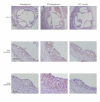The role of glucosamine-induced ER stress in diabetic atherogenesis
- PMID: 22474416
- PMCID: PMC3296270
- DOI: 10.1155/2012/187018
The role of glucosamine-induced ER stress in diabetic atherogenesis
Abstract
Cardiovascular disease (CVD) is the major cause of mortality in individuals with diabetes mellitus. However the molecular and cellular mechanisms that predispose individuals with diabetes to the development and progression of atherosclerosis, the underlying cause of most CVD, are not understood. This paper summarizes the current state of our knowledge of pathways and mechanisms that may link diabetes and hyperglycemia to atherogenesis. We highlight recent work from our lab, and others', that supports a role for ER stress in these processes. The continued investigation of existing pathways, linking hyperglycemia and diabetes mellitus to atherosclerosis, and the identification of novel mechanisms and targets will be important to the development of new and effective antiatherosclerotic therapies tailored to individuals with diabetes.
Figures



Similar articles
-
Molecular mechanisms linking diabetes to the accelerated development of atherosclerosis.Can J Diabetes. 2013 Oct;37(5):345-50. doi: 10.1016/j.jcjd.2013.06.001. Can J Diabetes. 2013. PMID: 24500563 Review.
-
The Role of Endoplasmic Reticulum Stress-Glycogen Synthase Kinase-3 Signaling in Atherogenesis.Int J Mol Sci. 2018 May 30;19(6):1607. doi: 10.3390/ijms19061607. Int J Mol Sci. 2018. PMID: 29848965 Free PMC article. Review.
-
Mechanisms linking diabetes mellitus to the development of atherosclerosis: a role for endoplasmic reticulum stress and glycogen synthase kinase-3.Can J Physiol Pharmacol. 2006 Jan;84(1):39-48. doi: 10.1139/Y05-142. Can J Physiol Pharmacol. 2006. PMID: 16845889 Review.
-
Role of endoplasmic reticulum stress signalling in diabetic endothelial dysfunction and atherosclerosis.Diab Vasc Dis Res. 2017 Jan;14(1):14-23. doi: 10.1177/1479164116666762. Epub 2016 Oct 20. Diab Vasc Dis Res. 2017. PMID: 27941052 Free PMC article. Review.
-
Glucosamine-induced endoplasmic reticulum dysfunction is associated with accelerated atherosclerosis in a hyperglycemic mouse model.Diabetes. 2006 Jan;55(1):93-101. Diabetes. 2006. PMID: 16380481
Cited by
-
Jatrorrhizine Improves Endothelial Function in Diabetes and Obesity through Suppression of Endoplasmic Reticulum Stress.Int J Mol Sci. 2022 Oct 11;23(20):12064. doi: 10.3390/ijms232012064. Int J Mol Sci. 2022. PMID: 36292919 Free PMC article.
-
Antioxidant activity of glucosamine and its effects on ROS production, Nrf2, and O-GlcNAc expression in HMEC-1 cells.Curr Res Toxicol. 2023 Sep 22;5:100128. doi: 10.1016/j.crtox.2023.100128. eCollection 2023. Curr Res Toxicol. 2023. PMID: 37808439 Free PMC article.
-
Endoplasmic reticulum is at the crossroads of autophagy, inflammation, and apoptosis signaling pathways and participates in the pathogenesis of diabetes mellitus.J Diabetes Res. 2013;2013:193461. doi: 10.1155/2013/193461. Epub 2013 May 21. J Diabetes Res. 2013. PMID: 23762873 Free PMC article. Review.
-
Apoptosis, autophagy & endoplasmic reticulum stress in diabetes mellitus.Indian J Med Res. 2016 Oct;144(4):515-524. doi: 10.4103/0971-5916.200887. Indian J Med Res. 2016. PMID: 28256459 Free PMC article. Review.
-
Inflammation, oxidative stress, apoptosis, and autophagy in diabetes mellitus and diabetic kidney disease: the Four Horsemen of the Apocalypse.Int Urol Nephrol. 2017 May;49(5):837-844. doi: 10.1007/s11255-016-1488-4. Epub 2016 Dec 29. Int Urol Nephrol. 2017. PMID: 28035619 Review.
References
-
- Yusuf PS, Hawken S, Ôunpuu S, et al. Effect of potentially modifiable risk factors associated with myocardial infarction in 52 countries (the INTERHEART study): case-control study. The Lancet. 2004;364(9438):937–952. - PubMed
-
- Yusuf S, Reddy S, Ôunpuu S, Anand S. Global burden of cardiovascular diseases. Part I: general considerations, the epidemiologic transition, risk factors, and impact of urbanization. Circulation. 2001;104(22):2746–2753. - PubMed
-
- Danaei G, Finucane MM, Lu Y, et al. National, regional, and global trends in fasting plasma glucose and diabetes prevalence since 1980: systematic analysis of health examination surveys and epidemiological studies with 370 country-years and 2·7 million participants. The Lancet. 2011;378(9785):31–40. - PubMed
-
- Hossain P, Kawar B, El Nahas M. Obesity and diabetes in the developing world—a growing challenge. The New England Journal of Medicine. 2007;356(3):213–215. - PubMed
-
- Haffner SM, Lehto S, Ronnemaa T, Pyorala K, Laakso M. Mortality from coronary heart disease in subjects with type 2 diabetes and in nondiabetic subjects with and without prior myocardial infarction. The New England Journal of Medicine. 1998;339(4):229–234. - PubMed
Publication types
MeSH terms
Substances
LinkOut - more resources
Full Text Sources
Medical
Miscellaneous
